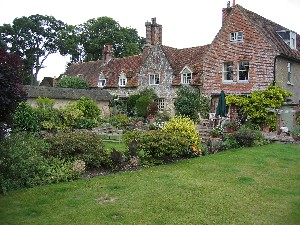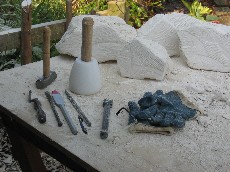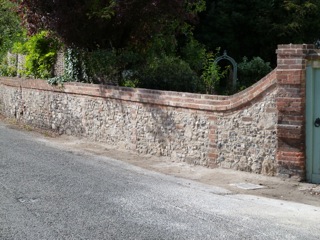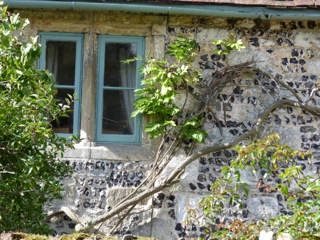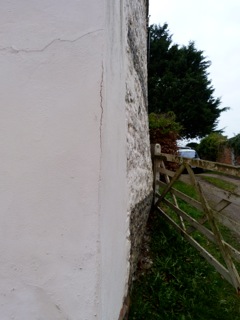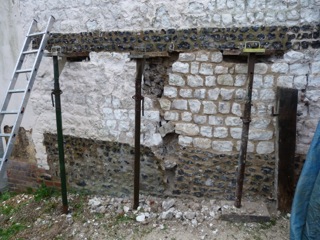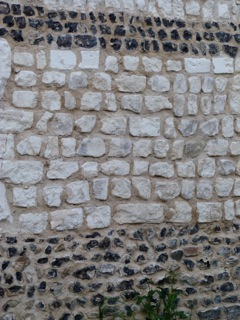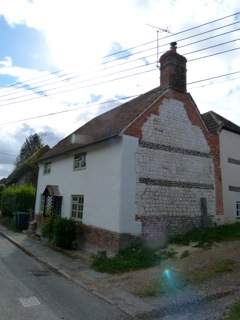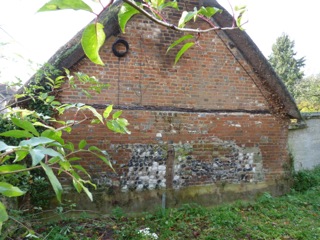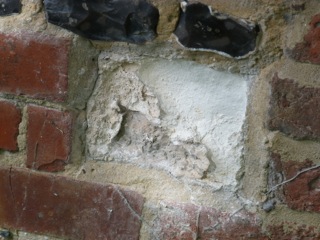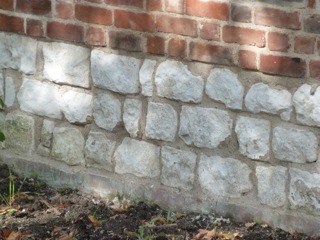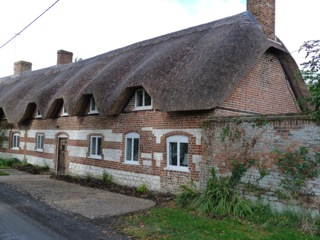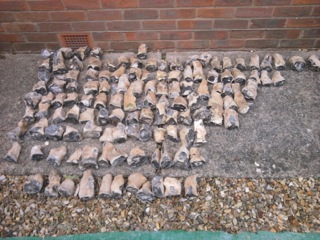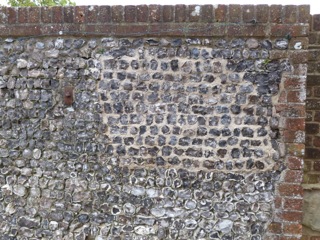Lime Mortar Pointing
There are many reasons for using lime mortar pointing (see 'Conservation Topics' section of this web site). One of the key reasons for using lime mortar pointing is to assist "Damp Proofing Stone and Solid Walls".
Here are a selection of projects we have carried out
Shrewton
This is a Grade 2 listed wall in Shrewton opposite the Church. It had fallen down and needed careful rebuilding to match the remaining wall. We were be able to match the old lime mortar for colour and texture by getting the right heavy aggregates and a suitable coloured chalk based lime, a 'Naturally Hydraulic Lime' on this occasion. New solid foundations were made with concrete rather than the old flints but thereafter all the old brick, stone and flints were reused.
At the same time that the wall was being rebuilt, some very necessary 'lime mortar pointing' was carried out on the main house. The issue was one of dampness in the 'solid stone and flint walls'. A very lean lime mortar had been used on the outer skin and the core or center of the wall had a mud mortar to hold the left over masonry together. Over the years much of this outer skin had been badly repointed with a cement mortar. This was locking the dampness into the muddy core giving all sorts of problems. We were able to clear out this cement and replace it with a suitable lime mortar, getting the colour and texture to match the original mortar. It is the design of the mortar that will allow it to assist the drying out of the wall over time.
Haxton
Haxton is an very pretty village beyond Netheravon. We were called to the cottage because there was a very serious bulge in the gable wall as you can see in the photo above.
Again this was a wall with a mud mortar holding the masonry core together. The outer skin had coursed chalk blocks with flint bands and the inner skin was mainly chalk.
The issue was again bad cement repairs, many coats of modern paints and a lack of maintenance. Water had been trapped in the core. Frost causes the start of the bulge which over the years gets a build up of fallen mortar into this core void. This too becomes damp, frosted and the bulge gets bigger. It was now a structural issue and so we called in a Structural Engineer to approve our repair plan. We discovered evidence of previous attempts to stabilise the situation with pinning but this had clearly been unsuccessful. A partial rebuild was required.
During the work we discovered that the front wall was chalk cob covered with a cement render, so this render also had to come off and be replaced with a lime render.
The photo above shows the wall being supported and re built. Note that we were able to make use of the flint band with its cement to provide strength for the strongboy.
Above, a photo of the rebuilt flint plinth using coursed chalk blocks which we cut on site, and the flint bands which no longer have cement holding them together.
This photo shows the completed project. The modern, non breathable paint has been removed from the brick work to prevent further damage.
West Amesbury
This is a delightful pair of cottages as you will see later. The photo above shows the initial problems of dampness in the gable wall. This was caused by raised ground levels, cement render over the plinths and lots of cement repairs to the mortar joints. Our solutions for the damp walls were to lower the ground levels and add a deep bed of gravel to assist drainage; to remove the cement render and replace all the cement pointing with a suitable lime mortar. Again the right design of mortar not only matches the original old mortar for colour and texture but it means the mortar is suitably absorbent and thus assists the gable to dry out.
The front of the cottage was showing significant chalk damage, which is so sad to see on these very pretty grade 2 listed cottages.
The issue was the bad repairs with cement; thus the moisture in the walls moves via the chalk rather than the mortar and the frost then causes damage to the chalk face.
Our work here was to remove all the cement pointing; turn some chalk blocks and replace others; and repoint with a suitable lime mortar.
You can see that we agreed to keep as much of the historic fabric of the cottage as possible. Thus although this had been dressed chalk originally, we did not carry out a whole scale 'restoration'; rather only replace chalk blocks which were structurally vital, and live with newly lime mortar pointed 'less than dressed chalk'.
This is the finished project which looks good and will have prevented further damage to the fabric of the building and kept it dryer.
Odstock
This is another major bulged flint wall. This time there was no need for a structural engineer. The issue here was that the old thatch or perhaps tiled roof had been replaced with a flat modern brick roof. This roof had failed to keep the water out of the wall in various places. Over time water gets into the mud mortar of the core, frost does its thing and the bulge gets bigger and bigger with the years.
As this was a very good quality flint wall with the best knapping and flint sizes chosen with care for each course, we laid out the flints to rebuild in the correct and original way.
Here we have one of the finished sections. We are often asked if we can blacken the lime mortar to be like the dirty old wall. This will happen over time naturally, although we are now using less polluting cars, tractors and lorries. We do not blacken our work.
